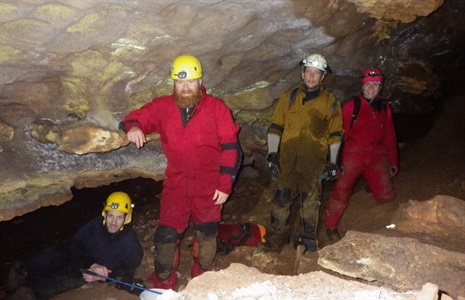Cave Springs Cave Natural Area, a 57-acre property located in Benton County, is an outstanding example of an Ozark Mountains cave stream. The natural area includes the cave itself (interior pictured above) and a portion of the cave’s recharge zone (areas where water enters the cave). Cave Springs Cave hosts a large population of the federally threatened Ozark cavefish (Troglichthys rosae). It also supports a summer maternity colony of the endangered gray bat (Myotis grisescens). Because ecosystems located within the cave can be disrupted by even the smallest change in water quality, field inventory of sensitive cave species is very important.
Armed with wetsuits, knee and elbow pads, helmets, and waterproof headlamps, scientists from the ANHC, the Arkansas Department of Environmental Quality, The Nature Conservancy of Arkansas , the U.S. Fish and Wildlife Service, the Illinois River Watershed Partnership, and the Arkansas Game and Fish Commissionentered the cave. Depending on the height of the cave and depth of the water, they swam, crawled, or waded, searching for the cavefish and noting other species in the cave. Their field inventory concluded that the cavefish population continues to remain stable. Samples for genetic studies were taken from some fish, as shown at right.
The federally threatened Ozark cavefish is very particular about its habitat — it only lives in streams that are constantly 55-60°F and located in permanently dark, underground passageways. The cavefish are small, reaching a maximum total length of about 75 mm (about 3 inches). Cavefish lack pigment, and appear pinkish-white because their translucent skin reveals blood and organs. Cavefish eyes are undeveloped and there is no remnant of the optic nerve in adults.
Gray bats were seen in the cave but only a few hibernating bats and they were not disturbed by the scientists. Later in the spring, the cave will be critical for mothers and new babies, so the cavefish surveys are purposely scheduled during the winter when people in the cave will cause the least disturbance to the fewest numbers of bats.
